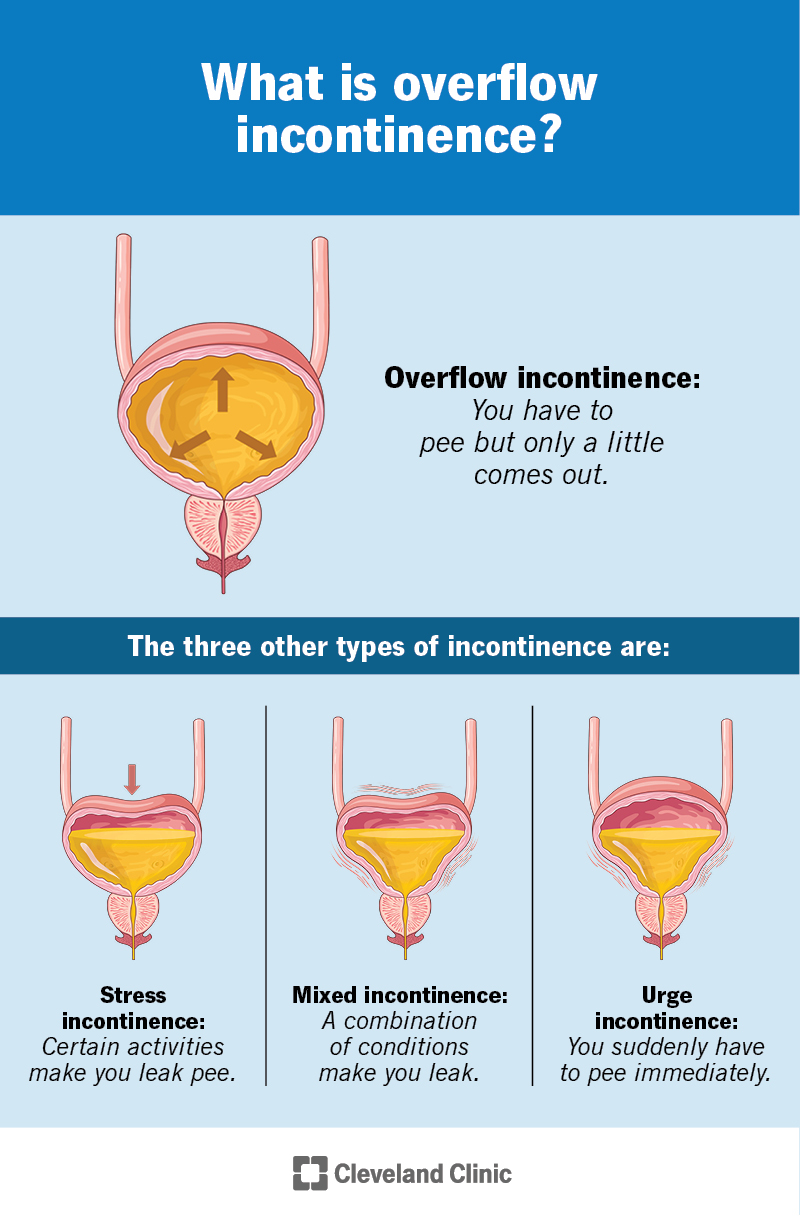Overflow incontinence causes a constant urine leak or dribble. Urinary retention causes overflow incontinence, usually due to a bladder obstruction, enlarged prostate or another problem that causes your bladder to get too full and overflow. Treatment includes bladder training, medications and catheterization.
Advertisement
Cleveland Clinic is a non-profit academic medical center. Advertising on our site helps support our mission. We do not endorse non-Cleveland Clinic products or services. Policy

Overflow incontinence (in-KON-teh-nents) is when you leak or dribble urine (pee) because your urinary bladder is too full. You may experience overflow incontinence if you can’t empty your bladder as often as you need to. This might be the case if you find it hard to empty your bladder all the way when you pee.
Advertisement
Cleveland Clinic is a non-profit academic medical center. Advertising on our site helps support our mission. We do not endorse non-Cleveland Clinic products or services. Policy
Some people think leaking pee is a natural part of aging. Getting older may increase your risk of developing overflow incontinence, but it doesn’t mean it’ll happen to you. But overflow incontinence can happen to anyone.
You may feel embarrassed, frustrated or angry about leaks. Those feelings are normal. But overflow incontinence doesn’t have to disrupt your life. It’s important to talk to a healthcare provider so they can make a proper diagnosis and determine the cause. They may recommend natural therapies, medications or other treatment options to help you manage leaks.
Overflow incontinence is a rare type of urinary incontinence. More common types of urinary incontinence include:
In the U.S., as many as 1 in 3 people has some type of urinary incontinence that causes them to leak pee. About 5% of people with chronic (long-lasting) urinary incontinence have overflow incontinence.
Overflow incontinence symptoms include:
Advertisement
The main cause of overflow incontinence is long-term urinary retention, or too-full bladder. Your bladder is an essential part of your urinary system. It may fill up due to:
Males with prostate issues are most likely to develop overflow incontinence after prostate surgery. Conditions like an enlarged prostate (benign prostatic hyperplasia) or prostate cancer can block your urethra, allowing only small amounts of pee to come out when you use the bathroom.
After prostate cancer surgery (prostatectomy), radiation therapy or surgery on your urethra, you can develop scar tissue. Scar tissue can cause a blockage (urethral stricture). If you can’t fully empty your bladder, it fills quickly again. When it gets full, you can leak pee.
You’re also more likely to get overflow incontinence if you have:
It’s a good idea to schedule an appointment with a healthcare provider if you have overflow incontinence symptoms. They’ll review your health history, ask questions about your symptoms and perform a physical exam. The physical exam may include a pelvic exam if you have a vagina or a digital rectal exam if you have a prostate.
To help make an accurate diagnosis, the provider may ask you to keep a bladder diary for two to three days. In your bladder diary, you’ll record:
They may also recommend tests to help make a diagnosis.
Tests for overflow incontinence include:
Advertisement
You may be able to manage overflow incontinence naturally with the following steps:
Overflow incontinence treatment depends on the exact cause. Your treatment may include:
Advertisement
If an enlarged prostate causes overflow incontinence, a healthcare provider may recommend an alpha-blocker to help shrink your prostate. They may recommend:
People with overflow incontinence leak small amounts of pee. But the leaks are frequent, and they can add up to a large amount of pee by the end of the day.
Absorbent underwear and urinary pads can catch these dribbles. But you may worry about an odor or how they look under your clothes. You may feel self-conscious about going out in public. This can lead to feelings of loneliness (isolation), anxiety and depression. Regular skin exposure to pee can also cause skin rashes and sores.
When your bladder doesn’t empty completely, you’re also at risk of developing UTIs, including bladder, prostate and kidney infections. The excess pee can also cause bladder stones. Bladder stones can cause an infection and irritation or pain.
Pressure from a bladder that’s constantly full can also cause kidney damage.
Many people with overflow incontinence see their symptoms improve after treating the conditions that cause urinary retention. It’s only in rare instances that people need a urinary catheter. It’s important to talk to a healthcare provider. They can recommend the most effective ways to manage overflow incontinence and minimize its impact on your life.
Advertisement
Steps like bladder training and double voiding can prevent your overfull bladder from leaking.
You may wish to wear absorbent underwear or pads until your treatment starts to work. It’s also a good idea to protect your skin from rashes and sores. Petroleum jelly or creams or ointments that contain zinc oxide can prevent irritation.
If overflow incontinence causes you stress, anxiety or depression, you may wish to speak to a therapist (counselor) or psychologist.
Schedule an appointment with a healthcare provider right away if you have any of the following:
You may want to ask a healthcare provider the following questions:
Another name for overflow incontinence is overflow urinary incontinence.
Overflow incontinence is a rare type of urinary incontinence. Many different types of urinary incontinence affect your control over your bladder.
Overflow incontinence can disrupt your life. It can make you self-conscious and afraid to stray too far from the bathroom. But this isn’t an inevitable part of aging, and treatment can help. With the right care, overflow incontinence can improve significantly and may even go away completely. Reach out to a healthcare provider if you have any questions or concerns.
It can be stressful (and painful) to have bladder disorders, like urinary incontinence or cystitis. But the urology providers at Cleveland Clinic are here for you.

Last reviewed on 09/11/2024.
Learn more about the Health Library and our editorial process.